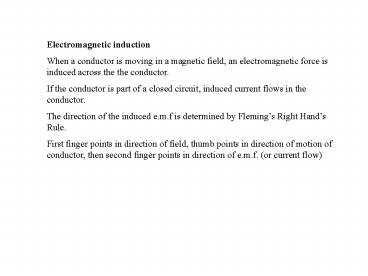Electromagnetic induction - PowerPoint PPT Presentation
1 / 7
Title:
Electromagnetic induction
Description:
If the conductor is part of a closed circuit, induced current flows in the conductor. ... Practical Motor : Bicycle dynamo & alternator ... – PowerPoint PPT presentation
Number of Views:29
Avg rating:3.0/5.0
Title: Electromagnetic induction
1
Electromagnetic induction When a conductor is
moving in a magnetic field, an electromagnetic
force is induced across the the conductor. If the
conductor is part of a closed circuit, induced
current flows in the conductor. The direction of
the induced e.m.f is determined by Flemings
Right Hands Rule. First finger points in
direction of field, thumb points in direction of
motion of conductor, then second finger points in
direction of e.m.f. (or current flow)
2
Lenzs law The direction of induced current flow
can also be determined by Lenzs law. An induced
current always flow to oppose the movement which
started it. From energy consideration, extra work
done from the agent is needed to give the
electrical energy due to induced current flow.
Mechanical energy is converted into electrical
energy
3
Faradays law of electromagnetic induction The
induced e.m.f. across a conductor is directly
proportional to the rate of cutting magnetic
field lines by the conductor.
4
a c Generator (dynamo) A coil is rotating in a
uniform magnetic field, with use of two slip
rings at connection ends. The output voltage
signal is an alternating signal at the same
frequency as the rotating coil. The voltage
output can be increased by 1. Using a strong
magnet, 2. Using more turns of coil, 3.
Increasing the rate of rotation of coil. Ex.
Sketch the waveform of the new voltage output if
a. the rotation rate is halved. B. the
slip rings is replaced with a commutator.
5
Ex. What happen if the magnets are moving around
the stationary coil ? Practical Motor Bicycle
dynamo alternator A rotating electromagnet
(rotor) is moving around a set of coils. The
magnetic field strength increases significantly
as rotation continues. There is no need for
movable electrical contacts that cause worn out.
6
Transformer When an a.c. current flows in the
primary coil, a changing magnetic field is set up
across the secondary coil. A varying induced
e.m.f. is obtained across the secondary coil.
Transformer equation For an ideal transformer
with no loss of energy. Secondary voltage
No. of turns in secondary coil Primary voltage
No. of turns in primary coil From energy
consideration, input power output power VpIp
VsIs
7
Practical transformers It is designed to prevent
the energy loss during operation. 1. Copper coil
is used to reduced energy loss in resistive
heating. 2. Soft iron core is used to reduce
energy loss in magnetization and
demagnetization. 3. Laminated iron core is used
to reduce the energy loss due to eddy current
flow in core.































